WORD NEWS
‘Eyes and ears’: Might drones show decisive within the Ukraine conflict? | Russia-Ukraine conflict
Warning: Some readers could discover among the scenes described on this article disturbing.
Kyiv, Ukraine – Ivan Ukraintsev, a stern-faced insurance coverage dealer turned director of a wartime charity offering essential help to Ukraine’s army forces, is on a mission: to assist Ukraine win the drone conflict.
He squints because the February solar streams by the home windows of a characterless Kyiv workplace advanced. Exterior, a siren wails, signalling the top of an air raid alert owing to army plane taking off and circling the skies in neighbouring Belarus. Ivan doesn’t flinch. He’s a well mannered however no-nonsense character, and he’s right here to speak about drones.
“If we [Ukraine] had sufficient drones, we may finish this conflict in two months,” he says firmly.
Ivan, who heads up the charity Starlife, had not too long ago returned from overseeing a drone supply to Bakhmut, a metropolis in jap Ukraine that has turn out to be the focus for months of bloody battles between Ukrainian and Russian forces. Trench warfare, pockmarked and corpse-ridden swathes of no man’s land, and fixed artillery bombardments have drawn comparisons to battlefield situations throughout World Conflict I.
There’s, nonetheless, one key distinction: the numerous drones hovering within the skies day and night time. It’s a twenty first century addition to traditional warfare that Ivan believes may show to be the deciding issue within the conflict in Ukraine.

‘You cease having feelings’
Ivan flicks out his telephone and pulls up a video of three Ukrainian troopers wearing camouflage clothes on the roof of an condominium block within the war-torn outskirts of Bakhmut. The low lighting suggests it’s both early morning or night.
One of many troopers pulls a pair of FPV (first-person view) goggles over his head. They seem much like snorkelling goggles however are encased in arduous plastic and fitted with a small display inside.
Utilizing each palms, he rigorously squeezes a set of toggles on a wi-fi handheld controller between his fingers and presses them gently forwards. A loud buzzing sound will be heard. A drone, the dimensions of a pc laptop computer, lifts off the bottom and out over the ruined cityscape. One other soldier holds onto the drone operator’s belt so he doesn’t lose stability and stumble off the sting of the constructing. It is a custom-made Ukrainian FPV Kamikaze drone, so named as a result of after taking off, it is not going to return.
Ivan flicks by his telephone till footage collected from the drone’s digital camera seems. A lone Russian soldier meanders by a community of muddy trenches 100 metres (330 ft) under the drone lens. The drone begins a speedy descent, honing in on the soldier. Ultimately, the person seems up, the drone so shut you may make out the expression of horror on his face. The footage ends abruptly. The drone can have exploded a second or two later, killing or severely injuring the soldier.
Ivan locks his display and locations his telephone on the desk. Such wartime footage, together with drone strikes, is usually circulated on the messaging app Telegram by official army and civilian channels on each side of the battle.
Ivan has been hands-on in delivering the drones, which Starlife has bought by fundraising campaigns, and ensuring they’re operational on his journeys to the entrance line.
These experiences have left him hardened to the horrors of fight. “When lots of people die, you cease having feelings. Both you undergo, otherwise you do one thing,” he explains, referring to the work that retains him busy.
Regardless of his sober exterior, Ivan feels empathy in direction of low-ranked Russian troopers, who he says are handled “like cannon fodder” by their superiors within the bloody battles round Bakhmut.
He says he believes the oppressive “old style” hierarchy is responsible. “On the entrance line in Bakhmut, you see the Russian commanders don’t have any respect for his or her troopers,” he says. “They use them as a disposable useful resource. You possibly can see 10 troopers being despatched out of the trenches, to allow them to pinpoint the place we strike at them from. They use them as bait as a result of as quickly as we regroup some place else, they ship one other 10 and one other.”
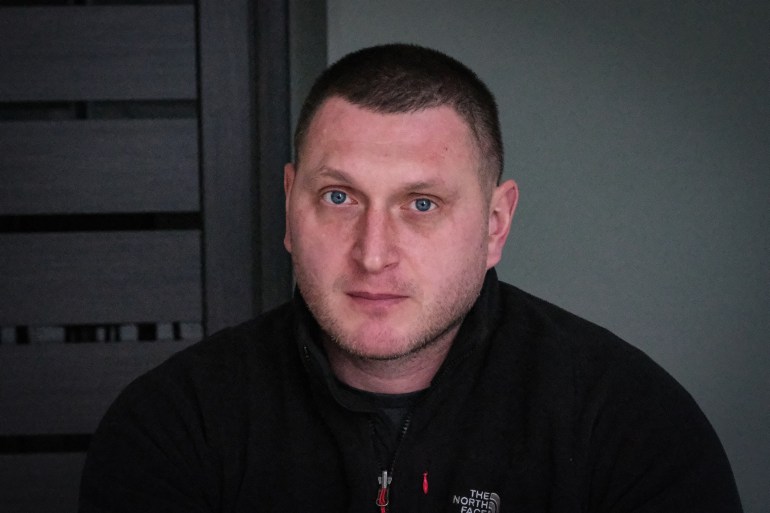
Ramped-up drone wars
The reliance on drones as a tactical expertise continues to exponentially improve for each side because the conflict in Ukraine continues into its 14th month.
The drones’ features fluctuate significantly, from reconnaissance missions to guided-missile assaults. They’ll additionally fluctuate in measurement and capabilities from repurposed industrial drones, such because the DJI Mavic 3, which prices lower than $2,000 and is principally used for surveillance functions, to fight drones such because the Turkish-made Bayraktar TB2, which requires a runway and is managed by an aircrew in a floor management station.
The significance of drones within the conflict has been apparent for the reason that first days when Ukrainian servicemen used them to watch Russia’s troop actions because it launched a multipronged assault into northern, southern and jap Ukraine. Nonetheless, Russian forces may typically determine the places of the Ukrainian operators through the use of expertise equivalent to DJI AeroScope, a drone detection platform.
In July, Ukrainian President Volodymyr Zelenskyy launched an “Military of Drones” enchantment for personal money to purchase a fleet of military-grade unmanned aerial automobiles (UAVs) from nations worldwide.
In keeping with Mykhailo Fedorov, Ukraine’s minister of digital transformation, 1,765 drones have been bought at a price of $3.4b and three,500 army personnel have been skilled to function them as a part of the venture.
In early October, Russia started placing infrastructure targets and civilian buildings with Iranian-made Shahed-136 kamikaze drones, in line with Ukrainian authorities, ushering in a brand new part of drone warfare. The Shahed-136 has a wingspan of two.5 metres (8.2 ft) and may hover above its goal till it’s instructed to assault.
Ukraine has since ramped up its efforts to counter Russia’s drone assaults.
A Ukrainian air and sea drone assault on the Crimean port of Sevastopol in late October broken Russia’s Black Sea flagship, the Admiral Makarov frigate.
In late February, a Ukrainian-made UJ-22 was introduced down about 80km (50 miles) southeast of the Kremlin. Air defence programs have since been put in in Moscow.
The Ukrainian military has additionally established 60 new assault drone squadrons, not less than one in each army brigade.
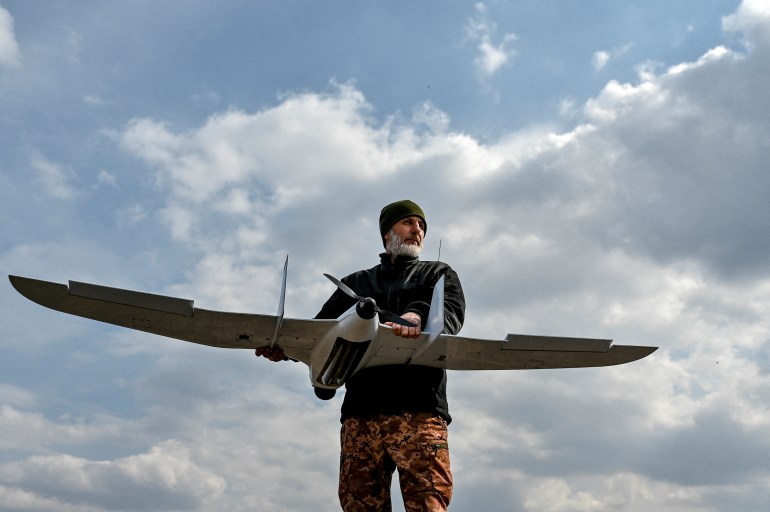
The military’s ‘eyes and ears’
Within the bloody battles raging in jap Ukraine, Ivan says the drones have turn out to be an “important software” in offensive and defensive methods.
“If you end up on the entrance strains and you’ve got drones obtainable, you are feeling that you’ve got a bonus,” he says.
Regardless of the lethal use of drones within the conflict, Ivan says he believes they’ll save lives on the entrance strains due to their extra exact concentrating on. “Drones can be utilized as a sniper,” he says, including that they’ll fly round buildings or different civilian obstacles to achieve enemy positions. “Tanks can solely be offensive, and artillery can’t goal people. If a shell hits a constructing, that’s it, for everybody”.
Concentrating on Russian army threats with elevated accuracy means civilians are much less more likely to be killed or infrastructure broken, in line with Ivan. It additionally permits items to preserve their ammunition.
Alternatively, he says, drones are used as the military’s “eyes and ears” to watch the enemy and shield Ukrainian troops. “What would you do earlier than drones? You would need to ship a soldier with a pair of binoculars and a radio to the highest of a hill.” A state of affairs that he says places the soldier at vital danger.
Ulrike Franke, a senior fellow on the European Council of Overseas Relations, says she believes that probably the most revolutionary side of drones in warfare is the reconnaissance they supply. “Rapidly, you get actually cheaply, actually simply 24/7 surveillance within the sky and at fairly low hierarchical ranges in an armed power,” Franke mentioned in an Al Jazeera documentary referred to as Drones and the Way forward for Conflict.
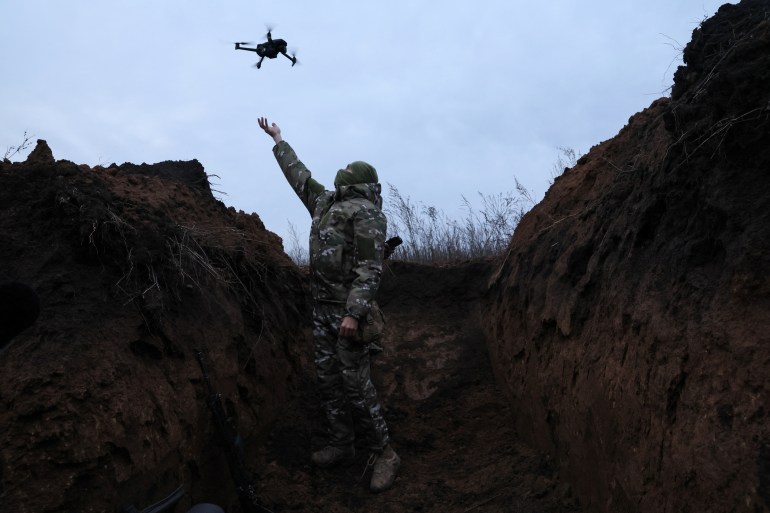
Not sufficient
The issue, Ivan says, is that the Ukrainian military – which purchases the vast majority of its drones from overseas, typically utilizing funds donated by way of the Military of Drones initiative or entities like Starlife’s basis – merely doesn’t have sufficient.
Ivan’s charity is an offshoot of Starlife LLC, a significant Ukrainian insurance coverage firm, which says it has raised virtually $500,000 in its newest marketing campaign for drones, which began in mid-January.
It nonetheless isn’t sufficient, in line with Ivan. “Cash for drones stays the most important barrier to Ukraine profitable the conflict,” he says matter-of-factly.
About half of the muse’s donations comes from overseas. Nonetheless, he says, in contrast to Ukrainians who’ve few objections to offering charitable donations for drones, many overseas benefactors are reluctant to supply such cash.
“Within the West, there’s some naivety on the subject of charitable donations,” he says. “Persons are completely satisfied to assist us with medicines and garments, however do you suppose we want medication or drones extra? It’s like your leg is being reduce piece by piece, and somebody provides you medication so that you don’t bleed out as a substitute of eradicating the particular person chopping it.”
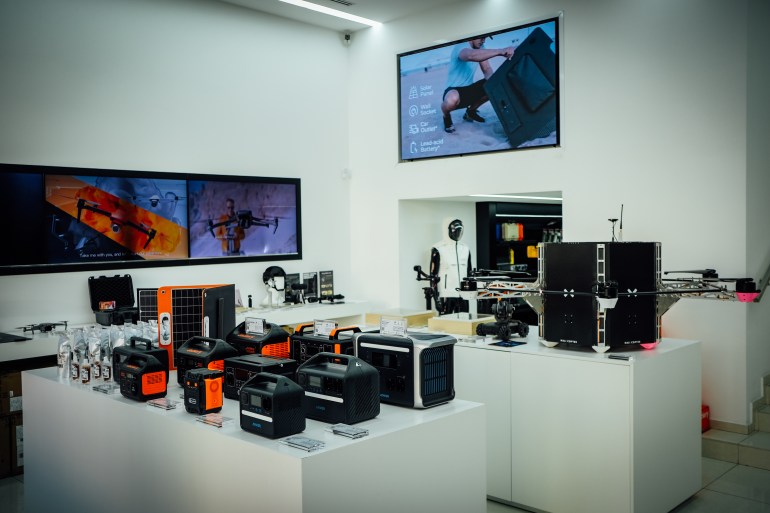
‘Conflict is a set off for progress’
Serhii, who solely needed to present his first title, is a talkative, 32-year-old drone salesman with a neat buzzcut and tattoos stretching down his arms. He weaves his means round stacks of economic drones produced by the Chinese language producer DJI.
The store the place he works is situated at one finish of busy Khreshchatyk Road in central Kyiv and was, earlier than February 24, 2022, the go-to place for purchasing a industrial drone. “I used to promote to individuals who needed to shoot footage from their travels,” he says. “Virtually all the time, they simply used drones for enjoyable, as a passion. Now all gross sales are associated to the conflict.”
Most of the retailer’s prospects nowadays are civilians who’re buying drones for army personnel they know.
The store’s window show, which seems out onto a bustling thoroughfare, was as soon as stuffed with snazzy advertising posters displaying the newest drone merchandise. Now, mannequins stand absolutely kitted out in fight gear and ballistic helmets alongside energy mills and a big drone, its wingspan the identical peak as Serhii.
“Everybody within the retailer realised within the first days of the conflict that we wanted to know all the things we may about drones,” he says, explaining that their reconnaissance capabilities have been helpful to the Ukrainian resistance efforts as Russian troops superior to the outskirts of Kyiv. “Now, even I can perceive the rules of easy methods to construct a drone from scratch or easy methods to decide one aside and modify it so as to add grenades, for instance,” he says.
Serhii describes a battle of minds wherein Ukrainian civilians and army personnel are pressured to consistently develop inventive strategies to counter Russian developments.
He factors to a cumbersome piece of equipment encased in a inexperienced plastic field and hoisted a metre into the air on a steel pole for example of such revolutionary problem-solving. The contraption, which he refers to as Olha, a standard feminine Ukrainian title, is a neighborhood invention designed to scramble the situation of a DJI operator, which Russian expertise was intercepting. It has saved many lives, he says, however already, Ukrainian drone specialists have needed to develop a brand new machine as a result of Olha isn’t appropriate with the newest drones.
Serhii sees these technological developments as one thing constructive. “Conflict is a set off for progress,” he says, wanting up as he scans a supply.
Then, he completes a sale for a buyer, handing over a field containing a industrial drone to a timid-looking girl who rests it on her shoulder and shuffles out of the shop.
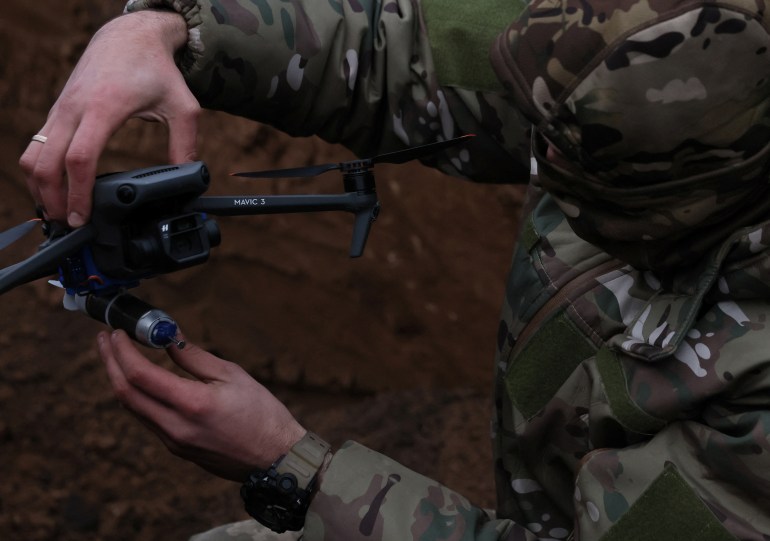
The age of drone warfare
The speedy improvement of drones in recent times and the built-in synthetic intelligence (AI) expertise they’re outfitted with have raised moral considerations amongst some specialists, significantly over using so-called killer robots, or deadly autonomous weapons.
David Bielecki, the operations director of Flytronic, a Polish drone maker, says in Drones and the Way forward for Conflict that “within the close to future, a UAV will in all probability fly over a goal, determine it’s a goal, and perhaps sooner or later, it should assault.”
Elizabeth Minor of the Marketing campaign to Cease Killer Robots informed the documentary makers {that a} main concern with autonomous weapons is “the erosion of human management over using power in addition to the rising automation over the selections to kill”.
9 years of casual United Nations talks in Geneva aimed toward forming worldwide floor guidelines for army drones have made little headway.
A UN report steered that deadly autonomous weapons with a “hearth, overlook and discover” functionality have been already utilized in Libya’s internecine battle in 2020 when Turkish-made Kargu-2 drones in full-automatic mode attacked an unspecified variety of combatants.
Toby Walsh – an Australian educational and AI skilled on the College of New South Wales in Sydney who, like Minor, campaigns towards killer robots – warns that the deployment of autonomous drones in Ukraine may turn out to be an actual risk. “I believe we’ll look again and realise we fought a conflict which modified the very nature of conflict itself,” he says.
“Within the First World Conflict, we invented the machine gun on a tank, and that modified the character of the conflict; within the Second World Conflict, we invented aerial bombardment of enemy cities,” he explains. “I get the sensation historians will look again on the conflict in Ukraine and realise how drones and autonomy began to take off, and that was a step that modified the character of conflict.”
Walsh expects that worldwide regulation will ultimately be launched to cease the potential use of killer drones. “The query,” he says, “is how rapidly.”
“I believe we’ll get there as a result of these are in the end going to be weapons of mass destruction,” he says.
Rapidly changing into normalised?
The near-constant footage shared on messaging apps, social platforms and within the media of drones getting used within the Ukraine conflict for army goals, equivalent to destroying tanks or attacking enemy positions, has raised the query of whether or not using drones within the theatre of conflict is quick changing into normalised.
Colin Alexander, a senior lecturer in political communications at Nottingham Trent College in the UK, has researched the position of drones in warfare and says the general public dialogue across the moral use of drones in a battle has often centred round asymmetrical warfare, such because the two-decade-old US drone marketing campaign in Yemen.
Nonetheless, the Ukraine battle doesn’t current the identical fast moral conundrum as a result of it’s a “very public show of symmetrical warfare”, he says.
“On this conflict, I wouldn’t say you might have completely balanced budgets, however Russia are utilizing drones, and Ukraine are utilizing drones. They each have a number of technical experience and tools,” he says.
“Simply because each side have entry to them doesn’t make them proper,” he provides. “Nonetheless, there’s a realist side to this: In case you’ve acquired drones, and drones are attacking you, then wouldn’t you utilize drones in response?”
Trending
-
Bank and Cryptocurrency11 months ago
Cheap Car Insurance Rates Guide to Understanding Your Options, Laws, and Discounts
-
Bank and Cryptocurrency11 months ago
Why Do We Need an Insurance for Our Vehicle?
-

 entertainement5 months ago
entertainement5 months agoHOUSE OF FUN DAILY GIFTS
-
WORD NEWS12 months ago
Swan wrangling and ‘steamy trysts’: the weird lives and jobs of the king’s entourage | Monarchy
